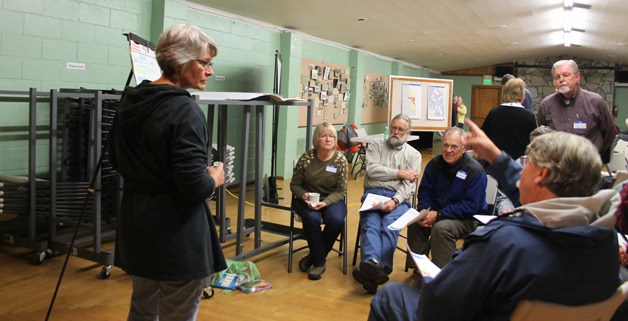Getting people to think about Clinton’s future went hand-in-hand with discussions of current woes and challenges such as a lack of sewers, absentee property owners, and needed industry during an Island County planning meeting Thursday night.
With about 40 people in attendance, Clinton Community Council leaders set out what Clinton’s rural area of intense development (RAID) is, why it was established and what it allows. The state-mandated and court-defended area is practically set in stone, said Brad Johnson, principal planner with Island County.
There are two zones within the rural area of intense development: rural center (commercial) and rural residential. Anything that was already developed within the area, which is roughly the stretch along Highway 525 from the ferry to just past Bob Galbreath Road, can remain what it is or have a similar function. If a single family residence is within the rural center, it can remain even if destroyed, Johnson said. But an undeveloped lot within the rural residential cannot be developed into a commercial use.
Only a few restrictions exist within the rural center area: no salvage yards, no single-family residences, and no buildings larger than 15,500 square feet. So don’t expect a Walmart or Cabela’s in Clinton any time soon.
“There’s a lot of flexibility in the uses,” he said.
The building size restriction was a major impediment to attracting anchor businesses, Maury Hood said. As a commissioner of the Clinton Water and Sewer District and a Clinton Community Council member, he asked if and how some of the restrictions and regulations could change to better attract a large business to the area.
“We can’t get a Trader Joe’s with a (15,500) square foot limit,” Hood said.
After a short presentation by Johnson and some of the council members, the crowd was split into a few small groups to think about what Clinton needs in the next 20 years. One of the guiding questions was about which properties may be poorly categorized within the rural center or rural residential. In previous meetings, properties along the east side of the highway, just up from the ferry terminal, have been cited as examples of an incorrect designation. Currently some of the properties have single family residences on them, and that is not likely to change any time soon.
But a passing glance at many of the small groups’ poster sheets instead focused on some of the blights plaguing Clinton’s commercial heart. A common concern was the lack of a draw. Why would someone walk over on the ferry from Mukilteo, a few people asked?
Finding businesses and industries that make sense for Clinton is the focus of a study being conducted on behalf of the Port of South Whidbey. The port district contracted a La Conner-based firm, Beckwith Consulting Group, to review shopping, living and business potential in Clinton. One of its upcoming major undertakings is a 12-hour session with several focus groups Thursday, Dec. 3 at the Clinton Community Hall.
“It’s not just about who lives in Clinton, it’s about everything that affects Clinton,” said Steve Price of Beckwith Consulting Group.
According to Island County projections, South Whidbey is not expected to see much population growth over the next two decades. The majority of that growth is expected in the Freeland and Langley areas. Without much growth expected, the lingering question for Clinton and county leaders is what to do with the existing land.
The non-elected, volunteer Clinton Community Council is trying to gather input and help give voice to the unincorporated area’s interests. A unified voice is stronger, said President Jack Lynch and Curt Gordon, a port commissioner who also serves on the council. Offering opinions and desires of residents and business owners is encouraged by the council, which meets the last Monday of each month.



